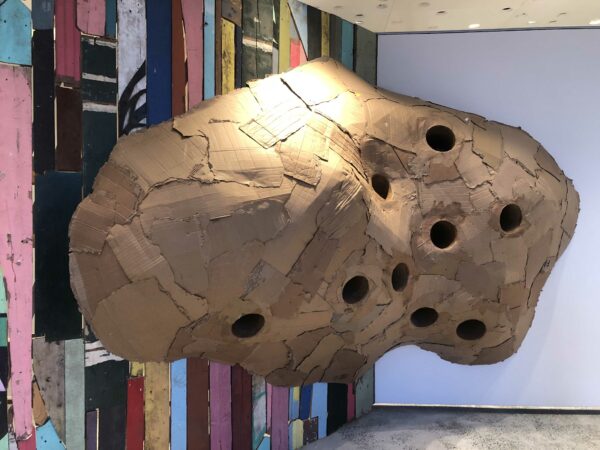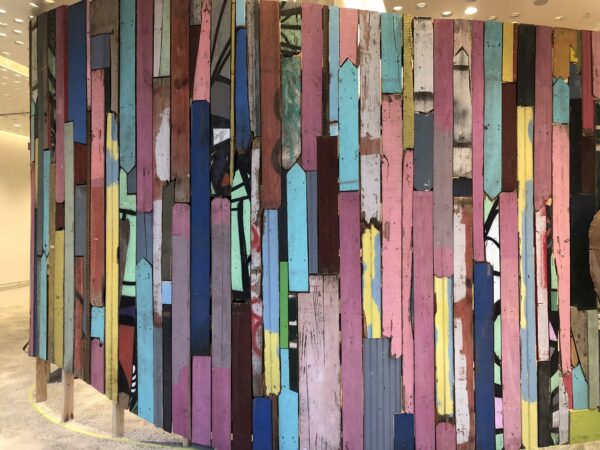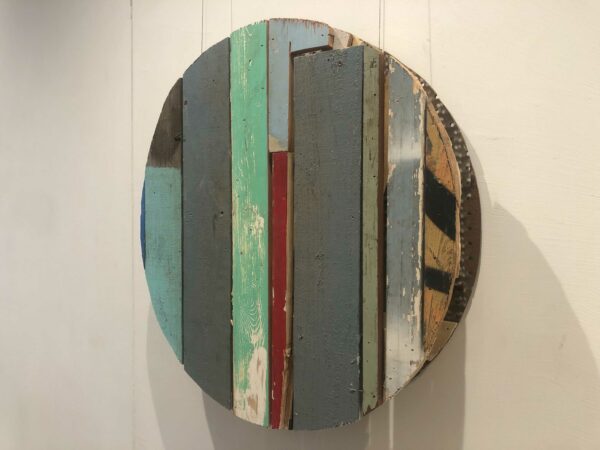
“Patrick Renner: Once & Future Architecture,” on view at Architecture Center Houston. Photo: Emily Peacock
Patrick Renner’s solo exhibition Once and Future Architecture at Architecture Center Houston features a monumental and painterly sculpture made of found and repurposed materials. Building on his singular artistic language, Renner’s gritty and tender work explores the capacity of art and architecture to generate, incubate, and transform ideas for the maker and viewers alike.
The form that Renner’s sculpture takes and the materials he uses are inspired by the architectural nests mud daubers (harmless wasps) create. The term “nest” is perhaps a bit misleading because these are not homes or dwellings, but incubation spaces. Adult wasps laboriously create their nests with mud, seal their larvae inside, and abandon the nest. The holes that we see in the nests are actually the result of young wasps carving their way out of and erupting from the surface of dried mud. These architectural nests are temporary spaces for generation, protection, and ultimately transformation, concepts that are mirrored in Renner’s sculpture and in his practice. He recycles materials, processes, and ideas into new work, sometimes even incorporating past artworks; he is always innovating and reinventing his approach.

“Patrick Renner: Once & Future Architecture,” on view at Architecture Center Houston. Photo: Emily Peacock
Materially, both Renner and mud daubers use refuse to create their structures. Renner finds and stores unaltered, colorful and weathered wooden planks, trashed cardboard, paint cans, and a plethora of other reclaimed materials. The way Renner collects and repurposes materials deemed unusable by many reminds me of artists like El Anatsui and Ian Gerson, although Renner sites Rodin, Brancusi, Gordan Matta-Clark, Martin Puryear, and Anne Hamilton as his major influences. In fact, a metal object embedded into the lower structure was part of Renner’s first public sculptural work, directly inspired by Rodin. This is not the only old artwork that finds its way back into this sculpture.
On his initial site visit for the show, the holes in the ceiling of the exhibition space reminded Renner of wooddauber, a sculpture he made in 2012, which featured intricate strips of veneer, layered and interlocking like a jigsaw puzzle. wooddauber is now embedded into the surface of this larger sculpture and serves as a visual thesis or maquette. By using refuse, Renner transforms the idea of what these materials can be and what they can mean.

“Patrick Renner: Once & Future Architecture,” on view at Architecture Center Houston. Photo: Emily Peacock
Despite the subversive nature of using discarded and reclaimed materials, I find that there is a reverent and sacred tone in Renner’s installation. There is a tenderness in the way the materials were selected and reconfigured into a patchwork quilt or bandage-like surface. I feel a sense of temporary protection in this space, as if I am visiting a clinic, shelter, shrine or temple. It is a feeling that I could return to time and again to experience a slow, rumbling change within myself and the way I understand this monumental structure. It brings me back to 2016, when I visited the Cy Twombly Gallery every week for a year, which was a deeply cathartic experience.
Oddly enough, Cy Twombly was the inspiration behind one of Renner’s small sculptures that line the interior wall. The layers of connections Renner shares with past and current artists adds to a deep sense of reverence. At the same time, he embraces various imperfections: for example, his decisions to preserve sharpie marks on wooden planks and to leave tape on the floor, which was used to map the structure. On a recent visit to see the space, Renner told me, “Art is precious and I love it when it’s not.”

“Patrick Renner: Once & Future Architecture,” on view at Architecture Center Houston. Photo: Emily Peacock
In the interior space, there is also an installation of Chunklets. They belong to an ongoing series for which Renner collects discarded bits and pieces while cutting down larger boards for other works. He then rearranges the small chunks into compositions. Where the entire sculpture feels painterly, these Chunklets come across as small paintings. They are beautiful shards, seemingly cut from larger gemstones. Only for this set of Chunklets, the edge of each is coated in stabilized mud, which materially connects back to the wasps and their nests. I love the way the making of these objects leans into randomness, chance, and intuition. This is part of a generative and transformative practice, one that is always evolving.
I admire the sense of precariousness and tenuousness in Renner’s work. He seems to embrace the impermanence of all things, both in this installation and in his studio practice. A lot of the refuse materials making up this structure are likely to be used in future iterations of Renner’s work. This makes me think that these materials and the forms they create are not meant to be permanent. Akin to the mud dauber nests, these are not homes or dwellings, rather they are temporary incubation spaces.
Renner creates architectural, sculptural, and artistic spaces for brief refuge, as a way to navigate through life. The evolution of his artistic language and creative practice is what remains a constant in a sea of uncertainty. Renner has built a naturally evolving, expanding, and synergistic practice that embraces adaptability, risk, and randomness as tools for philosophical and artistic survival.
Peewee Ruiz, Jonathan Rico, Jaykub Rodriguez, Mike Kirby, and Linda Renner (Patrick’s mom) were collaborators on Once & Future Architecture.
Stay tuned for Tape and Take, the closing reception on Saturday, August 19, from 1-5 p.m., where visitors are invited to designate areas of the sculpture’s surface to be cut out and purchased at a rate per square foot. The Chunklets will also be available for sale at the end of the show.
Once & Future Architecture is on view at Architecture Center Houston through August 18, 2023.


